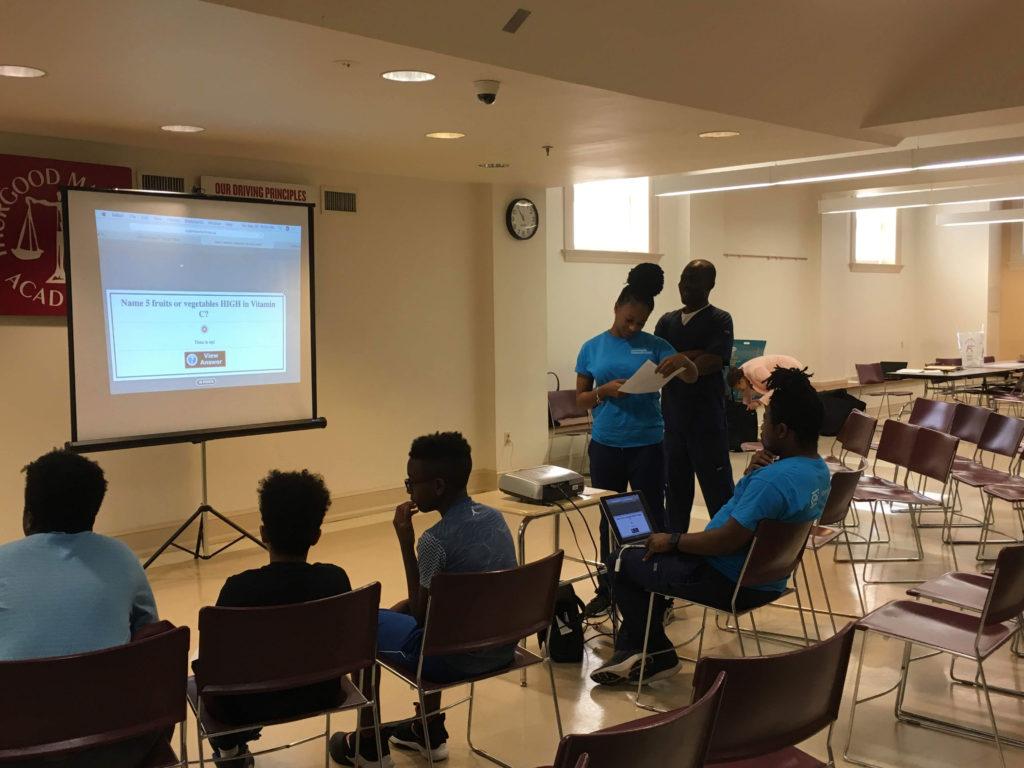Students in the nursing school are wrapping up the first installation of a two-month program teaching D.C. middle schoolers about heart disease and healthy living.
The program – funded by a September grant from the Nurse Practitioner Healthcare Foundation – partnered the School of Nursing with the AnBryce Foundation, a nonprofit that focuses on community-building for middle school-age students. Eleven students in the nursing school have attended the Saturday Institute at Thurgood Marshall Academy every week since Sept. 29 to teach children how to keep their hearts healthy and how social factors can impact their health.
The program will come to a close on Saturday but will start up again next semester, faculty said.
Karen Dawn, a co-principal investigator of the program and an assistant professor of nursing, said people in Ward 8 – where Thurgood Marshall Academy is located – die 10 to 15 years earlier than people living in other areas in D.C. She said children in Ward 8 need to be taught that diet, exercise, genetics and location all impact heart health, and children should start eating foods that are good for the heart and stay physically active at an early age to prevent heart disease.
Dawn said the program has helped middle school students understand that factors outside their control – like not having access to parks, sidewalks or grocery stores – impact how they stay healthy.
“They need to dig a little deeper and work a little harder than someone who has those luxuries,” Dawn said.
She said nursing students work with the middle school students to teach heart-healthy practices through interactive activities like watching videos and playing Jeopardy-style games.
Dawn said the Nurse Practitioner Healthcare Foundation grant helped the nursing school buy cameras, which the middle schoolers use to take photos and describe what makes their hearts healthy or unhealthy. She said the project, coined the “PhotoVoice Project,” will be featured in an exhibit Saturday at Thurgood Marshall Academy.
“Our job in the School of Nursing, especially mine being the director of community health and public health for the undergraduates, is to make sure we’re helping people in the communities that we work in,” she said. “We don’t just teach our students, we want them to be able to go out and help the communities and see some sustainability there.”
Peter Bryant, a second-year nursing student who volunteered with the Saturday Institute as part of a community and public health course, said his group focused on choices that students can make to create healthy habits from an early age.
“People are constantly inundated with information about issues at a national level or at a state level, these kind of broader issues that don’t have a huge effect on our day-to-day lives,” Bryant said. “I hope the long-term effect on the kids is that they realize that if they focus some of their efforts on more local issues, they can really have an outside impact on the day-to-day lives of people in their community.”
Rebecca Gandelman, a second-year nursing student who volunteers at the school, said she hopes the initiative helps middle school students realize that, despite social determinants of health like the location of their neighborhood or their socioeconomic status, they can still positively influence the health of their community through healthy eating and exercise.
“Education empowers people to take an active role in their health and evoke change,” Gandelman said in an email. “When communities are equipped with knowledge about their health, factors within their environment that contribute positively and negatively to their health and cost-effective strategies for community improvement, they can begin to modify their choices in order to promote a healthy lifestyle.”
Ramon Bacani, a second-year nursing student, said that although it was initially challenging to get the middle schoolers to open up about heart health concerns, hearing stories about where they live and what obstacles they face has helped to shape the structure of the program.
Bacani added that students wrote and mailed letters to community leaders in D.C. about what can be changed to help local communities become healthier.
“Even at a young age, they still have the power to make changes and make decisions to help themselves out in the future and help their communities out,” Bacani said.





